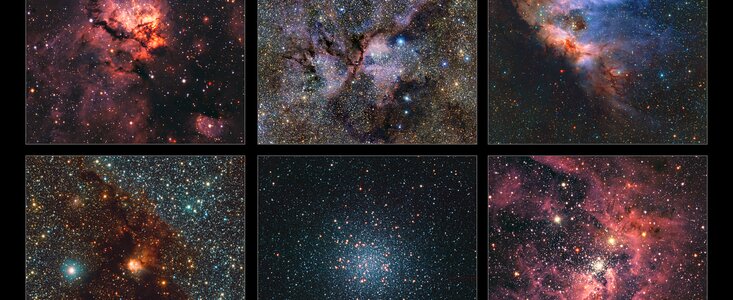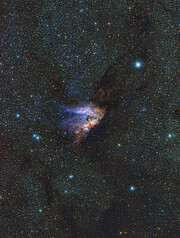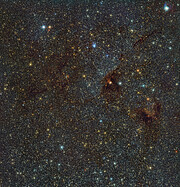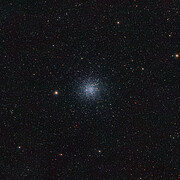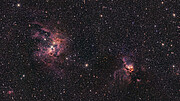Pressemeddelelse
Det mest detaljerige billede af Mælkevejen i infrarødt lys er optaget med ESOs teleskoper
26. september 2024
En gruppe astronomer har offentliggjort et enormt kort over Mælkevejen i infrarødt lys. Det indeholder mere end 1,5 milliarder objekter, og det er det mest detaljerede mælkevejskort, som nogensinde er fremstillet. Med Det europæiske Sydobservatoriums (ESOs) VISTAteleskop har forskerne holdt øje med de centrale dele af vores galakse i mere end 13 år. Med 500 terabyte data er dette det største observationsprojekt, som er udført med et af ESOs teleskoper.
"Vi har gjort så mange opdagelser, at det har ændret vores syn på vores galakse for evigt," siger Dante Minniti, som er astronom ved Universidad Andrés Bello i Chile, og som har ledet projektet.
Det rekordstore kort består af 200 000 billeder, optaget med ESOs VISTA ― the Visible and Infrared Survey Telescope for Astronomy. Teleskopet, som befinder sig på ESOs Paranal Observatorium i Chile har som hovedopgave at kortlægge store områder af himlen. Forskerholdet har brugt VISTAs infrarøde kamera VIRCAM, som kan se igennem den gas og støvet, som er udbredt i hele vores galakse. Derfor kan det opfange stråling fra de mest skjulte steder i Mælkevejen, og kigge ind ad interesante vinduer i vore omgivelser i galaksen.
Dette enorme datasæt [1] dækker et himmelområde, som svarer til 8600 fuldmåner, og det indeholder omkring 10 gange flere objekter end et tidligere kort, som det samme forskerhold har udsendt tilbage i 2012. Det indeholder nyfødte stjerner, som ofte er indhyllede i et støvlag, og kugleformede stjernehobe - altså grupper af tætliggende stjerner, som indeholder millioner af de ældste stjerner i Mælkevejen. VISTA observerer i infrarødt lys, og det betyder, at teleskopet også kan finde meget kolde objekter, som lyser i disse bølglængder, såsom brune dværge ('fejlslagne' stjerner, som ikke har kunnet starte kernefusionen eller fritflyvende planeter, som ikke kredser om en stjerne.
Observationerne begyndte i 2010, og sluttede i første halvdel af 2023. De har omfattet i alt 420 nætter. Ved at observere hvert område af himlen mange gange, har forskerne ikke kun kunnet bestemme hvor disse objekter befinder sig, men de har også kunnet spore, hvordan de bevæger sig, og om deres lysstyrke ændrer sig. De har kortlagt stjerner, hvis lysstyrke varierer periodisk, og den slags stjerner kan bruges som målestokke for kosmiske afstande[2]. På den måde har vi nu fået et præcist 3D overblik over Mælkevejens indre dele, som hidtil har været skjult af støvtåger. Forskerne har også fulgt stjerner med høje hastigheder – altså stjerner, som bevæger sig hurtigt fordi de er blevet slynget ud fra de centrale dele af Mælkevejen efter at være kommet tæt på det supertunge sorte hul, som lurer derinde.
Det nye kort indeholder data, som er indhøstet som en del af oversigtsprojektet the VISTA Variables in the Vía Láctea (VVV) survey [3] og det ledsagende projekt VVV eXtended (VVVX) survey. "Projektet har været enormt, og det har kun været muligt fordi vi har hjulpet hinanden i et godt holdarbejde," siger Roberto Saito, som er astronom ved Universidade Federal de Santa Catarina i Brasilien, og som er hovedforfatter til den artikel, som offentliggøres idag i tidsskriftet Astronomy & Astrophysics for at fejre projektets afslutning.
Oversigtsprojekterne VVV og VVVX har allerede resulteret i mere end 300 videnskabelige artikler. Nu, hvor projekterne er afsluttede, vil den videnskabelige gennemgang af de indhøstede data fortsætte i de kommende årtier. I mellemtiden forbereder ESOs Paranalobservatorium sig på fremtiden: VISTA bliver opdateret med det nye instrument 4MOST, og ESOs Very Large Telescope (VLT) får det nye instrument MOONS. Tilsammen vil de to instrumenter kunne levere spektrer af millioner af de objekter, som er fundet i denne omgang, og der forventes utallige nye opdagelser.
Noter
[1] Datasættet er for stort til at kunne udsendes som et enkelt billede, men de bearbejdede data og objektkataloget kan findes på ESOs ESO Science Portal.
[2]En måde at måle afstanden til en stjerne er ved at sammenligne hvor klar den ser ud til at være set her fra Jorden med, hvor klar den i virkeligheden er, men den sidste værdi er ofte ukendt. Visse typer af stjerner ændres deres lysstyrke periodisk, og der er en meget tæt sammenhæng imellem hvor hurtigt de gør dette, og så hvor lysstærke de er i virkeligheden. Ved at måle disse ændringer kan astronomerne beregne stjernernes virkelige lysstyrke, og dermed deres afstand fra os.
[3] Vía Láctea er Mælkevejens latinske navn.
Mere information
Forskningsresultaterne her er offentliggjort i en artikel med titlen “The VISTA Variables in the Vía Láctea eXtended (VVVX) ESO public survey: Completion of the observations and legacy” i tidsskriftet Astronomy & Astrophysics (https://doi.org/10.1051/0004-6361/202450584). Data DOI: VVV, VVVX.
Forskerholdet består af R. K. Saito (Departamento de Física, Universidade Federal de Santa Catarina, Florianópolis, Brazil [UFSC]), M. Hempel (Instituto de Astrofísica, Dep. de Ciencias Físicas, Facultad de Ciencias Exactas, Universidad Andres Bello, Providencia, Chile [ASTROUNAB] and Max Planck Institute for Astronomy, Heidelberg, Germany), J. Alonso-García (Centro de Astronomía, Universidad de Antofagasta, Antofagasta, Chile [CITEVA] and Millennium Institute of Astrophysics, Providencia, Chile [MAS]), P. W. Lucas (Centre for Astrophysics Research, University of Hertfordshire, Hatfield, United Kingdom [CAR]), D. Minniti (ASTROUNAB; Vatican Observatory, Vatican City, Vatican City State [VO] and UFSC), S. Alonso (Departamento de Geofísica y Astronomía, CONICET, Facultad de Ciencias Exactas, Físicas y Naturales, Universidad Nacional de San Juan, Rivadavia, Argentina [UNSJ-CONICET]), L. Baravalle (Instituto de Astronomía Teórica y Experimental, Córdoba, Argentina [IATE-CONICET]; Observatorio Astronómico de Córdoba, Universidad Nacional de Córdoba, Argentina [OAC]), J. Borissova (Instituto de Física y Astronomía, Universidad de Valparaíso, Valparaíso, Chile [IFA-UV] and MAS), C. Caceres (ASTROUNAB), A. N. Chené (Gemini Observatory, Northern Operations Center, Hilo, USA), N. J. G. Cross (Wide-Field Astronomy Unit, Institute for Astronomy, University of Edinburgh, Royal Observatory, Edinburgh, United Kingdom), F. Duplancic (UNSJ-CONICET), E. R. Garro (European Southern Observatory, Vitacura, Chile [ESO Chile]), M. Gómez (ASTROUNAB), V. D. Ivanov (European Southern Observatory, Garching bei München [ESO Germany]), R. Kurtev (IFA-UV and MAS), A. Luna (INAF – Osservatorio Astronomico di Capodimonte, Napoli, Italy [INAF- OACN]), D. Majaess (Mount Saint Vincent University, Halifax, Canada), M. G. Navarro (INAF – Osservatorio Astronomico di Roma, Italy [INAF-OAR]), J. B. Pullen (ASTROUNAB), M. Rejkuba (ESO Germany), J. L. Sanders (Department of Physics and Astronomy, University College London, London, United Kingdom), L. C. Smith (Institute of Astronomy, University of Cambridge, Cambridge, United Kingdom), P. H. C. Albino (UFSC), M. V. Alonso (IATE-CONICET and OAC), E. B. Amôres (Departamento de Física, Universidade Estadual de Feira de Santana, Feira de Santana, Brazil), E. B. R. Angeloni (Gemini Observatory/NSF’s NOIRLab, La Serena, Chile [NOIRLab]), J. I. Arias (Departamento de Astronomía, Universidad de La Serena, La Serena, Chile [ULS]), M. Arnaboldi (ESO Germany), B. Barbuy (Universidade de São Paulo, São Paulo, Brazil), A. Bayo (ESO Germany), J. C. Beamin (ASTROUNAB and Fundación Chilena de Astronomía, Santiago, Chile), L. R. Bedin (Istituto Nazionale di Astrofisica, Osservatorio Astronomico di Padova, Padova, Italy [INAF-OAPd]), A. Bellini (Space Telescope Science Institute, Baltimore, USA [STScI]), R. A. Benjamin (Department of Physics, University of Wisconsin-Whitewater, Whitewater, USA), E. Bica (Departamento de Astronomia, Instituto de Física, Porto Alegre, Brazil [IF – UFRGS]), C. J. Bonatto (IF – UFRGS), E. Botan (Instituto de Ciências Naturais, Humanas e Sociais, Universidade Federal de Mato Grosso, Sinop, Brazil), V. F. Braga (INAF-OAR), D. A. Brown (Vatican Observatory, Tucson, USA), J. B. Cabral (IATE-CONICET and Gerencia De Vinculación Tecnológica, Comisión Nacional de Actividades Espaciales, Córdoba, Argentina), D. Camargo (Colégio Militar de Porto Alegre, Ministério da Defesa, Exército Brasileiro, Brazil), A. Caratti o Garatti (INAF- OACN), J. A. Carballo-Bello (Instituto de Alta Investigación, Universidad de Tarapacá, Arica, Chile [IAI-UTA]), M.Catelan (Instituto de Astrofísica, Pontificia Universidad Católica de Chile, Santiago, Chile [Instituto de Astrofísica UC]; MAS and Centro de Astro-Ingeniería, Pontificia Universidad Católica de Chile, Santiago, Chile [AIUC]), C. Chavero (OAC and Consejo Nacional de Investigaciones Científica y Técnicas, Ciudad Autónoma de buenos Aires, Argentina [CONICET]), M. A. Chijani (ASTROUNAB), J. J. Clariá (OAC and CONICET), G. V. Coldwell (UNSJ-CONICET), C. Contreras Peña (Department of Physics and Astronomy, Seoul National University, Seoul, Republic of Korea and Research Institute of Basic Sciences, Seoul National University, Seoul, Republic of Korea), C. R. Contreras Ramos (Instituto de Astrofísica UC and MAS), J. M. Corral-Santana (ESO Chile), C. C. Cortés (Departamento de Tecnologías Industriales, Faculty of Engineering, Universidad de Talca, Curicó, Chile), M. Cortés-Contreras (Departamento de Física de la Tierra y Astrofísica & Instituto de Física de Partículas y del Cosmos de la UCM, Facultad de Ciencias Físicas, Universidad Complutense de Madrid, Madrid, Spain), P. Cruz (Centro de Astrobiología, CSIC-INTA, Madrid, Spain [CAB]), I. V. Daza-Perilla (CONICET; IATE-CONICET and Facultad de Matemática, Astronomía, Física y Computación, Universidad Nacional de Córdoba, Córdoba, Argentina), V. P. Debattista (University of Central Lancashire, Preston, United Kingdom), B. Dias (ASTROUNAB), L. Donoso (Instituto de Ciencias Astronómicas, de la Tierra y del Espacio, San Juan, Argentina), R. D’Souza (VO), J. P. Emerson (Astronomy Unit, School of Physical and Chemical Sciences, Queen Mary University of London, London, United Kingdom), S. Federle (ESO Chile and ASTROUNAB), V. Fermiano (UFSC), J. Fernandez (UNSJ-CONICET), J. G. Fernández-Trincado (Instituto de Astronomía, Universidad Católica del Norte, Antofagasta, Chile [IA-UCN]), T. Ferreira (Department of Astronomy, Yale University, New Haven, USA), C. E. Ferreira Lopes (Instituto de Astronomía y Ciencias Planetarias, Universidad de Atacama, Copiapó, Chile [INCT] and MAS), V. Firpo (NOIRLab), C. Flores-Quintana (ASTROUNAB and MAS), L. Fraga (Laboratorio Nacional de Astrofísica, Itajubá, Brazil), D.Froebrich (Centre for Astrophysics and Planetary Science, School of Physics and Astronomy, University of Kent, Canterbury, United Kingdom), D. Galdeano (UNSJ-CONICET), I. Gavignaud (ASTROUNAB), D. Geisler (Departamento de Astronomía, Universidad de Concepción, Chile [UdeC]; Instituto Multidisciplinario de Investigación y Postgrado, Universidad de La Serena, Chile [IMIP-ULS] and ULS), O. E.Gerhard (Max Planck Institute for Extraterrestrial Physics, Germany [MPE]), W. Gieren (UdeC), O. A. Gonzalez (UK Astronomy Technology Centre, Royal Observatory Edinburgh, Edinburgh, United Kingdom), L. V. Gramajo (OAC and CONICET), F. Gran (Université Côte d’Azur, Observatoire de la Côte d’Azur, CNRS, Laboratoire Lagrange, Nice, France [Lagrange]), P. M. Granitto (Centro Internacional Franco Argentino de Ciencias de la Información y de Sistemas, Rosario, Argentina), M. Griggio (INAF-OAPd; Dipartimento di Fisica, Università di Ferrara, Ferrara, Italy and STScI), Z. Guo (IFA-UV and MAS), S. Gurovich (IATE-CONICET and Western Sydney University, Kingswood, Australia), M. Hilker (ESO Germany), H. R. A. Jones (CAR), R. Kammers (UFSC), M. A. Kuhn (CAR), M. S. N. Kumar (Centro de Astrofísica da Universidade do Porto, Porto, Portugal), R. Kundu (Miranda House, University of Delhi, India and Inter University centre for Astronomy and Astrophysics, Pune, India), M. Lares (IATE-CONICET), M. Libralato (INAF-OAPd), E. Lima (Universidade Federal do Pampa, Uruguaiana, Brazil), T. J. Maccarone (Department of Physics & Astronomy, Texas Tech University, Lubbock, USA), P. Marchant Cortés (ULS), E. L. Martin (Instituto de Astrofisica de Canarias and Departamento de Astrofísica, Universidad de La Laguna, San Cristóbal de la Laguna, Spain), N. Masetti (Istituto Nazionale di Astrofisica, Osservatorio di Astrofisica e Scienza dello Spazio di Bologna, Bologna, Italy and ASTROUNAB), N. Matsunaga (Department of Astronomy, Graduate School of Science, The University of Tokyo, Japan), F. Mauro (IA-UCN), I. McDonald (Jodrell Bank Centre for Astrophysics, The University of Manchester, UK [JBCA]), A. Mejías (Departamento de Astronomía, Universidad de Chile, Las Condes, Chile), V. Mesa (IMIP-ULS; Association of Universities for Research in Astronomy, Chile, Grupo de Astrofísica Extragaláctica-IANIGLA; CONICET, and Universidad Nacional de Cuyo, Mendoza, Argentina), F. P. Milla-Castro (ULS), J. H. Minniti (Department of Physics and Astronomy, Johns Hopkins University, Baltimore, USA), C. Moni Bidin (IA-UCN), K. Montenegro (Clínica Universidad de los Andes, Santiago, Chile), C. Morris (CAR), V. Motta (OAC), F. Navarete (SOAR Telescope/NSF’s NOIRLab, La Serena, Chile), C. Navarro Molina (Centro de Docencia Superior en Ciencias Básicas, Universidad Austral de Chile, Puerto Montt, Chile), F. Nikzat (Instituto de Astrofísica UC and MAS), J. L. NiloCastellón (IMIP-ULS and ULS), C. Obasi (IA-UCN and Centre for Basic Space Science, University of Nigeria, Nsukka, Nigeria), M. Ortigoza-Urdaneta (Departamento de Matemática, Universidad de Atacama, Copiapó, Chile), T. Palma (OAC), C. Parisi (OAC and IATE-CONICET), K. Pena Ramírez (NSF NOIRLab/Vera C. Rubin Observatory, La Serena, Chile), L. Pereyra (IATE-CONICET), N. Perez (UNSJ-CONICET), I. Petralia (ASTROUNAB), A. Pichel (Instituto de Astronomía y Física del Espacio, Ciudad Autónoma de Buenos Aires, Argentina [IAFE-CONICET]), G. Pignata (IAI-UTA), S. Ramírez Alegría (CITEVA), A. F. Rojas (Instituto de Astrofísica UC, Instituto de Estudios Astrofísicos, Facultad de Ingeniería y Ciencias, Universidad Diego Portales, Santiago, Chile and CITEVA), D. Rojas (ASTROUNAB), A. Roman-Lopes (ULS), A. C. Rovero (IAFE-CONICET), S. Saroon (ASTROUNAB), E. O. Schmidt (OAC and IATE-CONICET), A. C. Schröder (MPE), M. Schultheis (Lagrange), M. A. Sgró (OAC), E. Solano (CAB), M. Soto (INCT), B. Stecklum (Thüringer Landessternwarte, Tautenburg, Germany), D. Steeghs (Department of Physics, University of Warwick, UK), M. Tamura (Department of Astronomy, Graduate School of Science, University of Tokyo; Astrobiology Center, Tokyo, Japan, and National Astronomical Observatory of Japan, Tokyo, Japan), P. Tissera (Instituto de Astrofísica UC and AIUC), A. A. R. Valcarce (Departamento de Física, Universidad de Tarapacá, Chile), C. A. Valotto (IATE-CONICET and OAC), S. Vasquez (Museo Interactivo de la Astronomía, La Granja, Chile), C. Villalon (IATE-CONICET and OAC), S. Villanova (UdeC), F. Vivanco Cádiz (ASTROUNAB), R. Zelada Bacigalupo (North Optics, La Serena, Chile), A. Zijlstra (JBCA and School of Mathematical and Physical Sciences, Macquarie University, Sydney, Australia), og M. Zoccali (Instituto de Astrofísica UC and MAS).
ESO er den fremmeste fællesnationale astronomiorganisation i Europa, og verdens langt mest produktive jordbaserede astronomiske observatorium. 16 lande er med i ESO: Belgien, Brazilien, Danmark, Finland, Frankrig, Italien, Nederlandene, Polen, Portugal, Spanien, Sverige, Schweiz, Storbritannien, Tjekkiet, Tyskland og Østrig, og desuden værtsnationen Chile. ESO har et ambitiøst program, som gør det muligt for astronomer at gøre vigtige videnskabelige opdagelser. Programmet har focus på design, konstruktion og drift af stærke jordbaserede observatorier. Desuden har ESO en ledende rolle i formidling og organisering af samarbejde omkring astronomisk forskning. ESO driver tre enestående observatorier i verdensklasse i Chile: La Silla, Paranal og Chajnantor. På Paranal driver ESO VLT, Very Large Telescope, som er verdens mest avancerede observatorium for synligt lys, samt to oversigtsteleskoper. VISTA, som observerer i infrarødt, er verdens største oversigtsteleskop, og VLT Survey Teleskopet er det største teleskop bygget til at overvåge himlen i synligt lys. ESO er en af de største partnere i ALMA, som er det største eksisterende astronomiprojekt. For tiden bygges ELT, et 39 m optisk og nærinfrarødt teleskop på Cerro Armazones, tæt ved Paranal. Det bliver "verdens største himmeløje". Fra vore kontorer i Santiago, Chile understøtter vi vore aktiviteter i landet, og samarbejder med vore chilenske partnere og samfundet i sin helhed.
Links
-
- Forskningsartiklen
- Fotos af oversigtsteleskoperne på Paranal, blandt andre VISTA
- For journalister: Du kan abonnere på vore pressemeddelelser under embargo på dit eget sprog
Kontakter
Roberto K. Saito
Universidade Federal de Santa Catarina
Florianópolis, Brazil
E-mail: roberto.saito@ufsc.br
Dante Minniti
Universidad Andrés Bello
Santiago, Chile
E-mail: vvvdante@gmail.com
Phil Lucas
University of Hertfordshire
Hartfield, United Kingdom
E-mail: p.w.lucas@herts.ac.uk
Juan Carlos Muñoz-Mateos
ESO Media Officer
Garching bei München, Germany
Tel: +49 89 3200 6176
E-mail: press@eso.org
Ole J. Knudsen (Pressekontakt Danmark)
ESOs formidlingsnetværk
og Aarhus Space Centre, Aarhus Universitet
Aarhus, Danmark
Tel: +45 8715 5597
E-mail: eson-denmark@eso.org
Om pressemeddelelsen
| Pressemeddelelse nr.: | eso2413da |
| Navn: | Milky Way |
| Type: | Milky Way |
| Facility: | Visible and Infrared Survey Telescope for Astronomy |
| Instruments: | VIRCAM |
| Science data: | 2024A&A...689A.148S |
Our use of Cookies
We use cookies that are essential for accessing our websites and using our services. We also use cookies to analyse, measure and improve our websites’ performance, to enable content sharing via social media and to display media content hosted on third-party platforms.
ESO Cookies Policy
The European Organisation for Astronomical Research in the Southern Hemisphere (ESO) is the pre-eminent intergovernmental science and technology organisation in astronomy. It carries out an ambitious programme focused on the design, construction and operation of powerful ground-based observing facilities for astronomy.
This Cookies Policy is intended to provide clarity by outlining the cookies used on the ESO public websites, their functions, the options you have for controlling them, and the ways you can contact us for additional details.
What are cookies?
Cookies are small pieces of data stored on your device by websites you visit. They serve various purposes, such as remembering login credentials and preferences and enhance your browsing experience.
Categories of cookies we use
Essential cookies (always active): These cookies are strictly necessary for the proper functioning of our website. Without these cookies, the website cannot operate correctly, and certain services, such as logging in or accessing secure areas, may not be available; because they are essential for the website’s operation, they cannot be disabled.
Functional Cookies: These cookies enhance your browsing experience by enabling additional features and personalization, such as remembering your preferences and settings. While not strictly necessary for the website to function, they improve usability and convenience; these cookies are only placed if you provide your consent.
Analytics cookies: These cookies collect information about how visitors interact with our website, such as which pages are visited most often and how users navigate the site. This data helps us improve website performance, optimize content, and enhance the user experience; these cookies are only placed if you provide your consent. We use the following analytics cookies.
Matomo Cookies:
This website uses Matomo (formerly Piwik), an open source software which enables the statistical analysis of website visits. Matomo uses cookies (text files) which are saved on your computer and which allow us to analyze how you use our website. The website user information generated by the cookies will only be saved on the servers of our IT Department. We use this information to analyze www.eso.org visits and to prepare reports on website activities. These data will not be disclosed to third parties.
On behalf of ESO, Matomo will use this information for the purpose of evaluating your use of the website, compiling reports on website activity and providing other services relating to website activity and internet usage.
Matomo cookies settings:
Additional Third-party cookies on ESO websites: some of our pages display content from external providers, e.g. YouTube.
Such third-party services are outside of ESO control and may, at any time, change their terms of service, use of cookies, etc.
YouTube: Some videos on the ESO website are embedded from ESO’s official YouTube channel. We have enabled YouTube’s privacy-enhanced mode, meaning that no cookies are set unless the user actively clicks on the video to play it. Additionally, in this mode, YouTube does not store any personally identifiable cookie data for embedded video playbacks. For more details, please refer to YouTube’s embedding videos information page.
Cookies can also be classified based on the following elements.
Regarding the domain, there are:
- First-party cookies, set by the website you are currently visiting. They are stored by the same domain that you are browsing and are used to enhance your experience on that site;
- Third-party cookies, set by a domain other than the one you are currently visiting.
As for their duration, cookies can be:
- Browser-session cookies, which are deleted when the user closes the browser;
- Stored cookies, which stay on the user's device for a predetermined period of time.
How to manage cookies
Cookie settings: You can modify your cookie choices for the ESO webpages at any time by clicking on the link Cookie settings at the bottom of any page.
In your browser: If you wish to delete cookies or instruct your browser to delete or block cookies by default, please visit the help pages of your browser:
Please be aware that if you delete or decline cookies, certain functionalities of our website may be not be available and your browsing experience may be affected.
You can set most browsers to prevent any cookies being placed on your device, but you may then have to manually adjust some preferences every time you visit a site/page. And some services and functionalities may not work properly at all (e.g. profile logging-in, shop check out).
Updates to the ESO Cookies Policy
The ESO Cookies Policy may be subject to future updates, which will be made available on this page.
Additional information
For any queries related to cookies, please contact: pdprATesoDOTorg.
As ESO public webpages are managed by our Department of Communication, your questions will be dealt with the support of the said Department.
